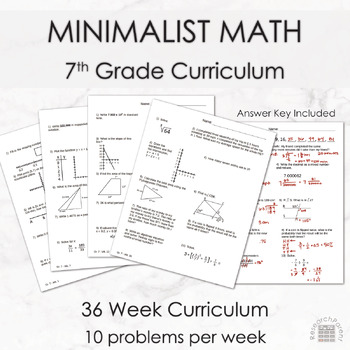Seventh Grade Minimalist Math Curriculum
- PDF
Description
Want to cover ALL of 7th grade math quickly and efficiently? These 36 worksheets can be used for 7th grade summer math review, to identify areas of weakness, or as a complete homeschool curriculum!
Traditional math curricula can be overwhelming. This Seventh Grade Minimalist Math curriculum contains 36 worksheets each with 10 problems covering the broad spectrum of 7th grade mathematical concepts.
Math Topics Included
- Understanding Numbers
- Word Problems
- Graphs, Charts, & Tables
- Fractions
- Geometry - Length, Area, Volume
- Geometry - Angles
- Ratios & Percents
- Statistics & Probability
- Algebra
- Calculations
Benefits and Uses
- use as a complete minimalist homeschool math curriculum
- cover material quickly and efficiently
- identify weaknesses or gaps in student's math knowledge
- free up more time for games and meaningful math activities
- use as summer review worksheets
The worksheets progress in difficulty to cover the full range of problems that a child would see in seventh grade. The later weeks exceed common core standards. The problems covered are equivalent to a pre-algebra curriculum. These worksheets were created using several separate comprehensive common core curricula to choose problem types (particularly Saxon 7/8, but also 7th-grade curricula by Singapore and Mammoth Math).
Please note that this Minimalist Math Curriculum does not contain the repetition that is common in a traditional curriculum. The child will likely need guidance to approach unfamiliar problem types. Despite the lack of repetition, week after week, the child is exposed to the same topics and grows in familiarity and critical thinking skills.
If using these worksheets as the core curriculum, I recommend supplementing with some math games to reinforce concepts and help grow the student's fluency in working with numbers. I also like to supplement with weekly logic puzzles to improve critical thinking skills.
Please let me know if you have any questions or concerns! I am happy to remedy any issues or offer a full refund within 365 days if you are not satisfied with your purchase.
Warmly,
Michelle of ResearchParent.com
P.S. Follow my store to be notified when I add new products. All of my products are marked 50% off for the first 24 hours after I upload them!





